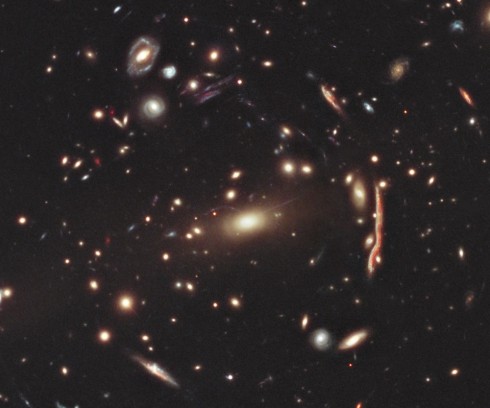A facinating simulation of what would happen if a Sun sized object passed through the solar system.
Tag: gravity
Gravitational and Electric Fields
Astronaut Don Pettit makes water droplets orbit a knitting needle. Instead of gravity, the attractive force that holds the water droplets in orbit is generated by the static electric charge on the knitting needle and on the water droplet. This works because gravity and electromagnetic forces follow similar rules (inverse square laws).
See more of his space-based experiments on Science off the Sphere on Physics Central.
A Galactic Cluster

The galaxy cluster MACS J1206. Galaxy clusters like these have enormous mass, and their gravity is powerful enough to visibly bend the path of light, somewhat like a magnifying glass.
These so-called lensing clusters are useful tools for studying very distant objects, because this lens-like behaviour amplifies the light from faraway galaxies in the background. They also contribute to a range of topics in cosmology, as the precise nature of the lensed images encapsulates information about the properties of spacetime and the expansion of the cosmos.
–NASA, ESA, M. Postman (STScI) and the CLASH Team: Hubble image of galaxy cluster MACS J1206
Build Your Own Solar System: An Interactive Model
National Geographic has a cute little game that lets you create a two-dimensional solar system, with a sun and some planets, and then simulates the gravitational forces that make them orbit and collide with each other. The pictures are pretty, but I prefer the VPython model of the solar system forming from the nebula.
The models starts off with a cloud of interstellar bodies which are drawn together by gravitational attraction. Every time they collide they merge creating bigger and bigger bodies: the largest of which becomes the sun near the center of the simulation, while the smaller bodies orbit like the planets.
This model also comes out of Sherwood and Chabay’s Physics text, but I’ve adapted it to make it a little more interactives. You can tag along for a ride with one of the orbiting planets, which, since this is 3d, makes for an excellent perspective (see the video). You can also switch the trails on and off so you can see the paths of the planetary bodies, note their orbits and see the deviations from their ideal ellipses that result from the gravitational pull of the other planets.
I’ve found this model to be a great way to introduce topics like the formation of the solar system, gravity, and even climate history (the ice ages over the last 2 million years were largely impelled by changes in the ellipticity of the Earth’s orbit).
National Geographic’s Solar System Builder is here.